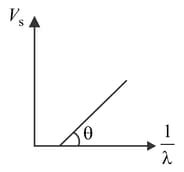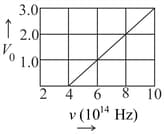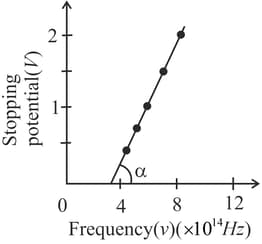The value of Plank's constant, if the slope of the graph of stopping potential vs frequency of incident light is is (given charge of an electron )
Important Questions on Dual Nature of Matter and Radiation
Electrons are emitted with kinetic energy from a metal plate by an irradiation of light of intensity and frequency Then, which of the following will be true?
In a photoelectric effect experiment, the graph of stopping potential versus reciprocal of wavelength obtained is shown in the figure. As the intensity of incident radiation is increased :

In photoelectric effect experiment, the slope of the graph of the stopping potential versus frequency gives the value of:
The stopping potential (in volt) as a function of frequency for a sodium emitter, is shown in the figure. The work function of sodium, form the data plotted in the figure, will be:
(Given: Planck’s constant , electron charge

Given, (in )
In an experimental observation of the photoelectric effect, the stopping potential was plotted against the incident light frequency as shown in the figure below:

If the work function of the metal is given by , the angle is given by
(Here, and are Planck's constant and charge of electron respectively).
Guess the shape of curve which shows the variation of with v in case of photoelectric emission shown by the relation where symbols have their usual meaning.
Given (in )

